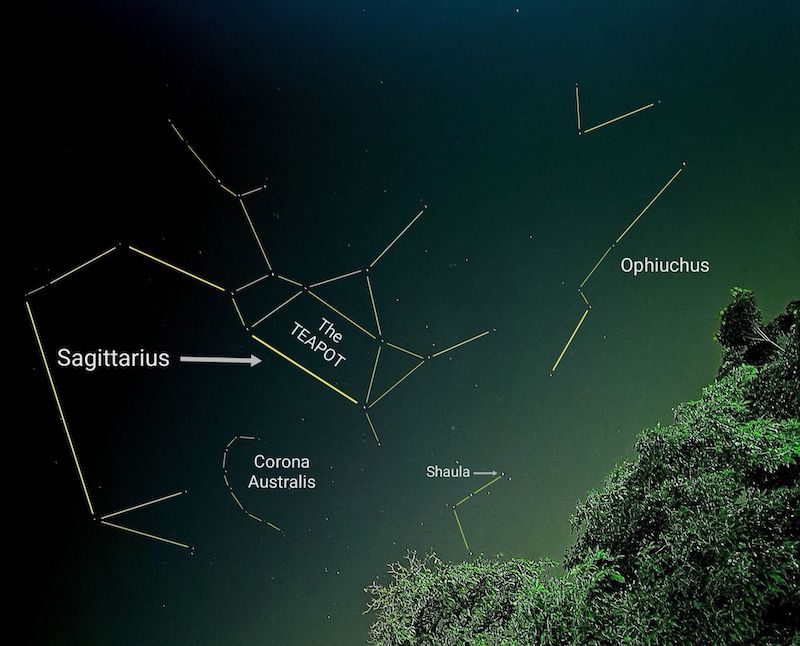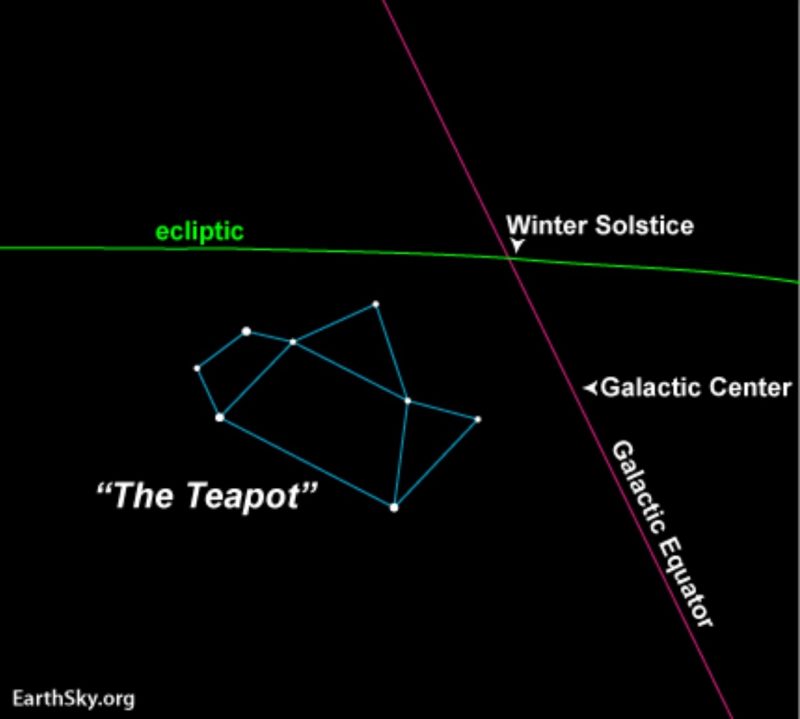
What is the Teapot?
The constellation of Sagittarius is supposed to be a centaur. That’s a mythical half man/half horse creature, carrying a bow and arrow. Good luck spotting the centaur in the stars!
But these same stars also make up what skywatchers call the Teapot in Sagittarius. And the Teapot is simple to spot. The Teapot is an asterism in the western part of the constellation.
It’s best viewed during the evening hours from about July to September. Best of all, when you’re looking toward the Teapot, you’re also looking toward the center of our Milky Way galaxy.
How to spot the Teapot
Unlike many star patterns, the Teapot actually looks like the object for which it’s named. The Teapot has a handle, spout and lid like a traditional teapot. Head to a dark rural location for your best views of this Milky Way region.
Because the sun passes in front of Sagittarius from about December 18 to January 20, the Teapot isn’t visible then. However, about half a year later – on July 1 – the Teapot climbs to its highest point for the night around midnight (1 a.m. Daylight Saving Time or DST), when it appears due south as seen from the Northern Hemisphere or due north as seen from the Southern Hemisphere.
As seen from our mid-northern latitudes, the Teapot rises in the southeast about three hours before it climbs to its highest point. The Teapot sets in the southwest about three hours afterward.
The Teapot returns to the same place in the sky about four minutes earlier with each passing day, or two hours earlier with each passing month. On August 1, the Teapot climbs to its highest point around 10 p.m. (11 p.m. DST). On September 1, it climbs highest around 8 p.m. (9 p.m. DST). On October 1, it’s highest around 6 p.m. (7 p.m. DST).
Another noteworthy point lies in this direction in space, the point at which the sun shines on the December solstice, around December 21 each year.

The center of our Milky Way
Once you’ve found the Teapot, imagine steam billowing out of the spout. In a dark sky, you can see this “steam” coming from the Teapot’s spout. Really, you’re seeing countless stars in our Milky Way.
Gaze into the midst of this “steam” – in the thickest part of it – and you’ll be gazing toward the center of our Milky Way galaxy. When you look in this direction, you’re looking toward the massive black hole at our galaxy’s heart. It’s a safe distance away at 30,000 light-years. We can’t see the black hole, of course, plus this region is shrouded in dust and gas clouds.
Sweep the area with binoculars or a telescope to see what star clusters pop into your view.
Two famous deep-sky objects in the form of gas clouds can be spotted in Sagittarius in this region of the Milky Way: M8, the Lagoon Nebula, and M20, the Trifid Nebula.

Bottom line: When you’re looking at the famous asterism of the Teapot in Sagittarius, you’re looking toward the center of the Milky Way galaxy.
The post The Teapot guides you to the galactic center first appeared on EarthSky.
from EarthSky https://ift.tt/3jtYcjm

What is the Teapot?
The constellation of Sagittarius is supposed to be a centaur. That’s a mythical half man/half horse creature, carrying a bow and arrow. Good luck spotting the centaur in the stars!
But these same stars also make up what skywatchers call the Teapot in Sagittarius. And the Teapot is simple to spot. The Teapot is an asterism in the western part of the constellation.
It’s best viewed during the evening hours from about July to September. Best of all, when you’re looking toward the Teapot, you’re also looking toward the center of our Milky Way galaxy.
How to spot the Teapot
Unlike many star patterns, the Teapot actually looks like the object for which it’s named. The Teapot has a handle, spout and lid like a traditional teapot. Head to a dark rural location for your best views of this Milky Way region.
Because the sun passes in front of Sagittarius from about December 18 to January 20, the Teapot isn’t visible then. However, about half a year later – on July 1 – the Teapot climbs to its highest point for the night around midnight (1 a.m. Daylight Saving Time or DST), when it appears due south as seen from the Northern Hemisphere or due north as seen from the Southern Hemisphere.
As seen from our mid-northern latitudes, the Teapot rises in the southeast about three hours before it climbs to its highest point. The Teapot sets in the southwest about three hours afterward.
The Teapot returns to the same place in the sky about four minutes earlier with each passing day, or two hours earlier with each passing month. On August 1, the Teapot climbs to its highest point around 10 p.m. (11 p.m. DST). On September 1, it climbs highest around 8 p.m. (9 p.m. DST). On October 1, it’s highest around 6 p.m. (7 p.m. DST).
Another noteworthy point lies in this direction in space, the point at which the sun shines on the December solstice, around December 21 each year.

The center of our Milky Way
Once you’ve found the Teapot, imagine steam billowing out of the spout. In a dark sky, you can see this “steam” coming from the Teapot’s spout. Really, you’re seeing countless stars in our Milky Way.
Gaze into the midst of this “steam” – in the thickest part of it – and you’ll be gazing toward the center of our Milky Way galaxy. When you look in this direction, you’re looking toward the massive black hole at our galaxy’s heart. It’s a safe distance away at 30,000 light-years. We can’t see the black hole, of course, plus this region is shrouded in dust and gas clouds.
Sweep the area with binoculars or a telescope to see what star clusters pop into your view.
Two famous deep-sky objects in the form of gas clouds can be spotted in Sagittarius in this region of the Milky Way: M8, the Lagoon Nebula, and M20, the Trifid Nebula.

Bottom line: When you’re looking at the famous asterism of the Teapot in Sagittarius, you’re looking toward the center of the Milky Way galaxy.
The post The Teapot guides you to the galactic center first appeared on EarthSky.
from EarthSky https://ift.tt/3jtYcjm

Aucun commentaire:
Enregistrer un commentaire